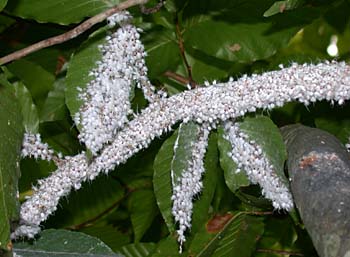
American Beech is a fairly common large tree of rich bottomland forests. The smooth bark, sharply toothed thin leaves with straight veins, and long sharply-pointed buds make this tree very easy to identify. In winter beech trees are easy to spot at a distance, as many pale tan dead leaves are retained on the trees all winter.
Carroll Co., VA 10/26/08.

The typical var. grandifolia occurs at mid-high elevations in the mountains. This variety's leaves are not hairy beneath or hairy only along the veins.
Carroll Co., VA 10/26/08.

In the Piedmont and Coastal Plain of North Carolina var. caroliniana (Loudon) Fernald & Rehder is the only variety. Its leaves are white-fuzzy beneath.

The nuts, which ripen in fall, are borne in small spine-covered woody husks. Durham Co., NC 6/8/03.

Beech Blight Aphids (Grylloprociphilus imbricator) are fairly common, forming dense colonies on small branches and the undersides of leaves. These are the host for caterpillars of the Harvester (Feniseca tarquinius), our only carnivorous butterfly.

The distinctive leaf buds are very long and sharply pointed.
Durham, NC 3/28/07.

The distinctive pale gray bark is very smooth. It is often covered with many species of lichens.
Orange Co., NC 10/15/06.

Durham, NC 3/28/07.

The bark remains nearly perfectly smooth even on very large trees, except when carved by humans.
Jones Co., NC 4/14/07.

Durham, NC 3/28/07.

It seems everybody loves a beech — trunk bases are often stained blackish by Beech Blight Aphids; Beechdrops (Epifagus americana), parasitic on the roots of beeches, are often seen sprouting nearby (bottom right of this photo).
Durham Co., NC 10/6/2012.